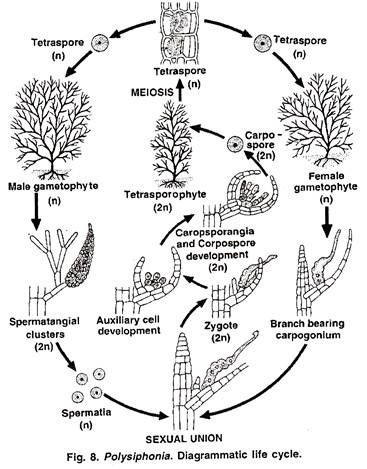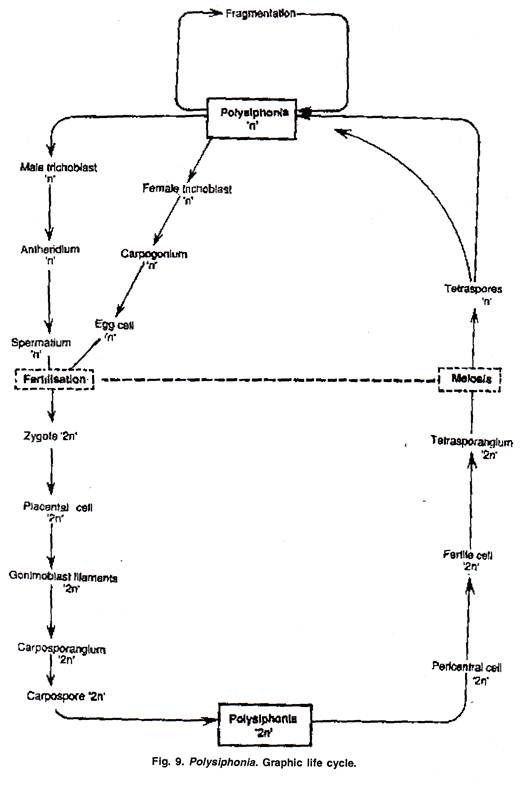In this article we will discuss about:- 1. Occurrence of Polysiphonia 2. Cell Structure of Polysiphonia 3. Growth 4. Life Cycle.
Occurrence of Polysiphonia:
Polysiphonia is a large genus with about 200 species. The genus is represented in India by about 16 species found is southern and western coasts of India. Some common Indian species are P. ferulacea, P. urceolata and P. variegata.
Most of the species are lithophytes i.e., found growing on rocks. Some species are epiphytic, found growing on other plants and algae e.g., P. ferulacea grows on Gelidium pusillum. P. variegata grows on the roots of mangroves. Some species are semi parasitic e.g., P. fastigiata is semiparasiite on Ascophyllum nodosum and Fucus.
Cell Structure of Polysiphonia:
The cells of central and pericentral siphons are cylindrical and elongated. The cell wall is differentiated into outer pectic and inner cellulosic layer. The cell contains a large central vacuole which is delimited by a membrane tonoplast. The cytoplasm is present between the cell wall and the central vacuole. The cell contains a number of red discoid chromatophores which lack pyrenoids.
The chromatophores contain pigments chlorophyll a, chlorophyll d, a carotene, (3 carotene, r-phycoerythrin and r-phycocyanin. The chromatophores are parietal in position (Fig. 2A). The central siphon cells and pericentral siphon cells posses single peripheral nucleus. The cytoplasm contains granules of floridean starch as food reserve.
Growth of Polysiphonia:
The growth takes place by the dome shaped apical cell located on the tip of central siphon. The apical cell cuts many cells on lower side by transverse divisions which form the central siphon. Some of the lower cells divide vertically to form pericentral cells.
Life Cycle of Polysiphonia:
The life cycle of Polysiphonia exhibits triphasic alternation of generation. In the life cycle three distinct phases occur.
These are:
1. Gametophytic phase.
2. Carposporophyte phase.
3. Tetra sporophyte phase.
Polysiphonia is dioecious plant. The male gametophytic plants and the female gametophytic plants are distinct. The haploid male gametophytic plant bears sex organs spermatangia which produce haploid spermatia. The haploid female gametophytic plant bears sex organs carpogonium.
The fertilization takes place in situ and diploid zygote nucleus is formed. The zygote develops in second phase of life cycle, the carposporophyte is dependent upon female gametophytic plant. The carporophyte is um shaped structure and forms diploid carpospores in carposporangia.
The carpospores germinate to make diploid tetrasporophytic plants. The tetrasporophytic plant bear tetra sporangia.
The diploid tetra sporangial nucleus divides meiotically to form four haploid tetra spores which again make gametophytic male and female plants. In life cycle of Polysiphonia two diploid phases carposprophyte and tetra sporophyte alternate with one haploid gametophytic phase. The life cycle of Polysiphonia can be called as triphasic diplobiontic with isomorphic alternation of generation (Figs. 8, 9).

